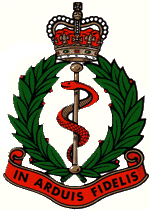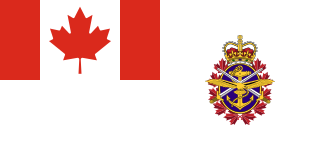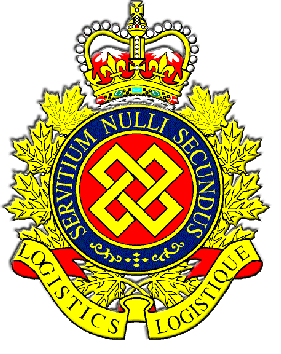Corps is a term used for several different kinds of organization. A military innovation by Napoleon I, the formation was first named as such in 1805. The size of a corps varies greatly, but two to five divisions and anywhere from 40,000 to 80,000 are the numbers stated by the US Department of Defense.

The Canadian Armed Forces are the unified military forces of Canada, including land, sea, and air commands referred to as the Canadian Army, Royal Canadian Navy, and the Royal Canadian Air Force. The CAF also operates several other commands, including the Canadian Forces Intelligence Command, the Canadian Joint Operations Command, and the Canadian Special Operations Forces Command.

Military police (MP) are law enforcement agencies connected with, or part of, the military of a state. In wartime operations, the military police may support the main fighting force with force protection, convoy security, screening, rear reconnaissance, logistic traffic management, counterinsurgency, and detainee handling.

The Royal Army Medical Corps (RAMC) is a specialist corps in the British Army which provides medical services to all Army personnel and their families, in war and in peace. The RAMC, the Royal Army Veterinary Corps, the Royal Army Dental Corps and Queen Alexandra's Royal Army Nursing Corps form the Army Medical Services.

The Canadian Forces Military Police provide police, security and operational support services to the Canadian Armed Forces (CAF) and the Department of National Defence (DND) worldwide.

A combat medic is responsible for providing emergency medical treatment at a point of wounding in a combat or training environment, as well as primary care and health protection and evacuation from a point of injury or illness. Additionally, medics may also be responsible for the creation, oversight, and execution of long-term patient care plans in consultation with or in the absence of a readily available doctor or advanced practice provider. Combat medics may be used in hospitals and clinics, where they have the opportunity to work in additional roles, such as operating medical and laboratory equipment and performing and assisting with procedures.

The Royal Canadian Medical Service is a personnel branch of the Canadian Armed Forces, consisting of all members of medical occupations. Nearly all members of the RCMS, along with the members of the Royal Canadian Dental Corps (RCDC), are employed in the Canadian Forces Health Services Group, an operational formation. The RCMS was formerly designated the Canadian Forces Medical Service until it was redesignated on October 9, 2013.
The uniforms of the Canadian Armed Forces are the official dress worn by members of Canada's military while on duty.

Personnel branches, in the Canadian Armed Forces (CAF), are groupings of related military occupations.

The Royal Canadian Logistics Service is a personnel branch of the Canadian Armed Forces (CAF).

The Royal Canadian Army Medical Corps (RCAMC) was an administrative corps of the Canadian Army.

The maroon beret in a military configuration has been an international symbol of airborne forces since the Second World War. It was first officially introduced by the British Army in 1942, at the direction of Major-General Frederick "Boy" Browning, commander of the British 1st Airborne Division. It was first worn by the Parachute Regiment in action in North Africa during November 1942.

Provosts are military police (MP) whose duties are policing solely within the armed forces of a country, as opposed to gendarmerie duties in the civilian population. However, many countries use their gendarmerie for provost duties.
A medical corps is generally a military branch or officer corps responsible for medical care for serving military personnel. Such officers are typically military physicians.

The Canadian Forces Health Services Group is a formation of the Canadian Forces within the Military Personnel Command. It includes personnel from both the Royal Canadian Medical Service and the Royal Canadian Dental Corps, fulfills all military health system functions from education and clinical services to research and public health, and is composed of health professionals from over 40 occupations and specialties in over 120 units and detachments across Canada and abroad.

The term military medicine has a number of potential connotations. It may mean:
Operation Pacific Angel is a recurring joint/combined humanitarian assistance mission sponsored by US Pacific Command (USPACOM) designed to bring humanitarian civic assistance (HCA) and civil-military operations (CMO) to areas in need in the Pacific region. It is conducted in locations throughout the Pacific theater to support the U.S. military charter of capacity building in partner nations. The operations contain elements of all four branches of the Department of Defense, including active duty, National Guard, and reserve members.

The unification of the Canadian Armed Forces took place on 1 February 1968, when the Royal Canadian Navy, Canadian Army, and Royal Canadian Air Force were merged to form the Canadian Armed Forces.
The Surgeon General is the professional head of the Canadian military health jurisdiction, the adviser to the Minister of National Defence and the Chief of Defence Staff on all matters related to health, and head of the Royal Canadian Medical Service. The Surgeon General may also be appointed the commander of the Canadian Forces Health Services Group, which fulfils all military health system functions from education and clinical services to research and public health. It consists of the Royal Canadian Medical Service, the Royal Canadian Dental Corps, personnel from other branches of the armed forces, and civilians, with health professionals from over 45 occupations and specialties in over 125 units and detachments across Canada and abroad. When appointed Director General Health Services, the Surgeon General is also the senior health services staff officer in the Department of National Defence. The Surgeon General is normally appointed to the Medical Household as Honorary Physician (QHP) or Honorary Surgeon (QHS) to His Majesty the King.

32 Service Battalion is a reserve combat service support (CSS) unit within the Canadian Army. The unit is formed under command of 32 Canadian Brigade Group in the 4th Canadian Division. The Service Battalion is composed of soldiers from the Corps of Royal Canadian Electrical and Mechanical Engineers and Royal Canadian Logistics Service to include: vehicle technicians, weapons technicians, cooks, financial service administrators, human resource administrators, material management technicians and mobile support equipment operators. It is located at LCol George Taylor Denison III Armoury in Toronto, Ontario.















